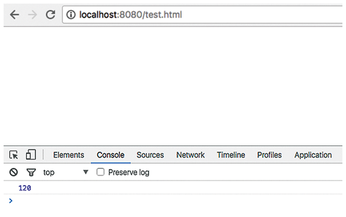Binary format for the web
APIs and System Calls
WebAssembly does not define or require any APIs or system calls. The underlying platform decides which APIs are available and how they are implemented, whether as web APIs in the browser or POSIX in native environments.
On the source code level, the Emscripten toolchain prepares the API calls for the corresponding interfaces of the deployed machine. This can happen during compilation time or dynamically at run time.
JavaScript API
In future, the idea is for browsers to load WebAssembly modules automatically with the use of a separate HTML attribute (<script type="module">). At the moment, this is not working, so you are left with two possibilities. (1) If you rely on emcc, the compiler creates a JavaScript file in addition to the WASM binary file that provides the WebAssembly module, loads the WASM code, and integrates the HTML code with <script src="mymodule.js">. (2) However, if you generate the WASM module in the text representation yourself, you don't want to use the JavaScript generated by emcc. Instead, you need to download the WebAssembly code (the WASM file) manually into a buffer via JavaScript and then compile and instantiate the code as demonstrated in the example from Listings 3 and 4.
Listing 3 shows an excerpt from a program implemented in s-expressions that calculates the factorial of a given number. If you want to avoid manual typing, WebAssembly Explorer transforms the C or C++ code into the WA(S)T format.
Listing 3
fact.wast (Excerpt)
When compiling the .wast file in the WebAssembly binary format (.wasm), the wast2wasm tool from the WABT Toolkit [24] is a big help. Typing
wast2wasm fact.wast -o fact.wasm
generates the file. The browser uses JavaScript to load this WASM file and executes the $fact() function. Listing 4 shows an excerpt from the HTML file, including the JavaScript part that integrates the WebAssembly code.
Listing 4
index.html (Excerpt)
Figure 6 displays the output of the factorial in the browser console (Chrome Developer Tools). The result is 120, because the parameter in the function call to results.instance.exports.fact in Listing 4 (line 9) is 5. The JavaScript importObject exports functions from JavaScript to WAST. The s-expressions in the WebAssembly code then access this file [29].

Benchmarking
In February 2017, Stefan Krause tested the performance of WebAssembly with various browsers [30] and compared them [31] with the fastest C and Java implementation of the benchmark. Depending on the browser, the performance of WebAssembly ranges between 130 and 190 percent compared with the native C implementation.
The Massive browser benchmark for WebAssembly also tests asm.js [32]. It compares four metrics:
- Main Thread Responsiveness measures browser availability (
main()thread) when loading large chunks of code. - Throughput is a typical benchmark, which measures the speed of execution.
- The Preparation test measures how much time elapses before the browser can run the code (i.e., load times).
- The Variance variable describes deviations in the framerate, which is mainly relevant for graphical applications such as games.
Compared with asm.js, WebAssembly performs better, which is attributable, among other things, to the binary format. Although asm.js delivers optimized JavaScript (gzip and minifier), the code in WebAssembly binary format is 10 to 20 percent more streamlined.
After downloading the binary code, the browsers can decode and parse it faster than with JavaScript from asm.js. In contrast to asm.js, WebAssembly is not limited to JavaScript when using and optimizing CPU features, which results in more speed advantages [33] [34].
Buy this article as PDF
(incl. VAT)
Buy Linux Magazine
Subscribe to our Linux Newsletters
Find Linux and Open Source Jobs
Subscribe to our ADMIN Newsletters
Support Our Work
Linux Magazine content is made possible with support from readers like you. Please consider contributing when you’ve found an article to be beneficial.

News
-
Linux Servers Targeted by Akira Ransomware
A group of bad actors who have already extorted $42 million have their sights set on the Linux platform.
-
TUXEDO Computers Unveils Linux Laptop Featuring AMD Ryzen CPU
This latest release is the first laptop to include the new CPU from Ryzen and Linux preinstalled.
-
XZ Gets the All-Clear
The back door xz vulnerability has been officially reverted for Fedora 40 and versions 38 and 39 were never affected.
-
Canonical Collaborates with Qualcomm on New Venture
This new joint effort is geared toward bringing Ubuntu and Ubuntu Core to Qualcomm-powered devices.
-
Kodi 21.0 Open-Source Entertainment Hub Released
After a year of development, the award-winning Kodi cross-platform, media center software is now available with many new additions and improvements.
-
Linux Usage Increases in Two Key Areas
If market share is your thing, you'll be happy to know that Linux is on the rise in two areas that, if they keep climbing, could have serious meaning for Linux's future.
-
Vulnerability Discovered in xz Libraries
An urgent alert for Fedora 40 has been posted and users should pay attention.
-
Canonical Bumps LTS Support to 12 years
If you're worried that your Ubuntu LTS release won't be supported long enough to last, Canonical has a surprise for you in the form of 12 years of security coverage.
-
Fedora 40 Beta Released Soon
With the official release of Fedora 40 coming in April, it's almost time to download the beta and see what's new.
-
New Pentesting Distribution to Compete with Kali Linux
SnoopGod is now available for your testing needs

